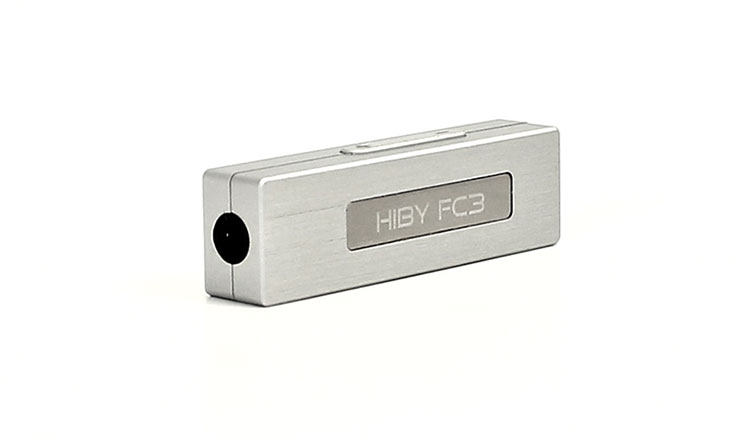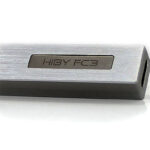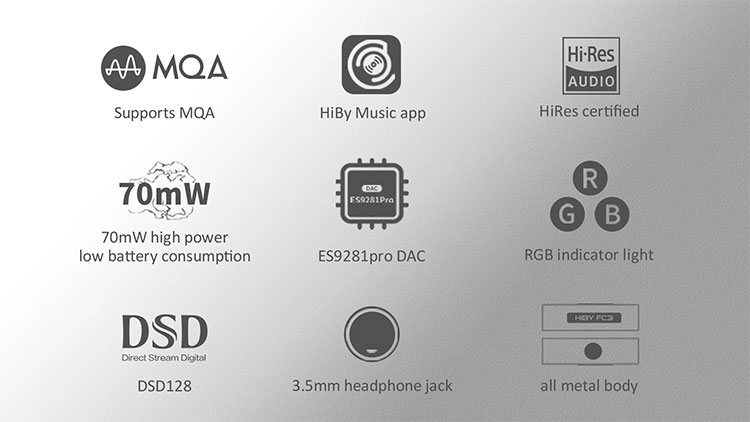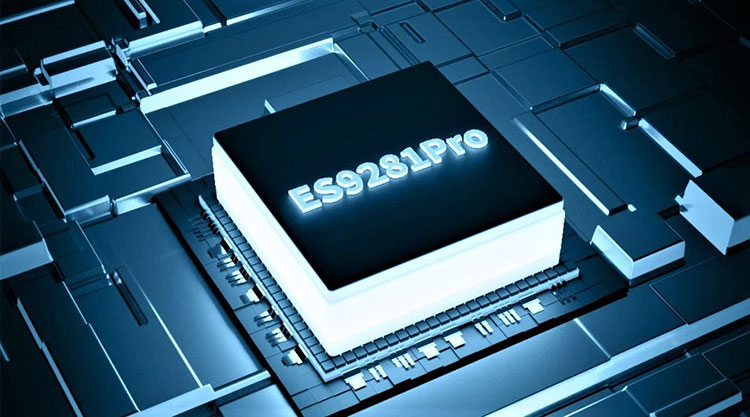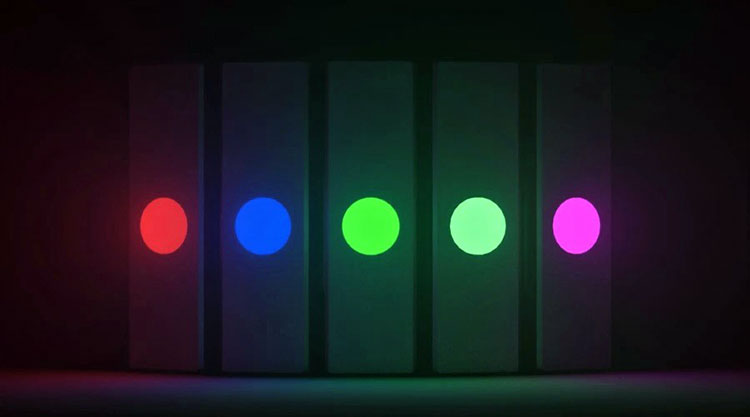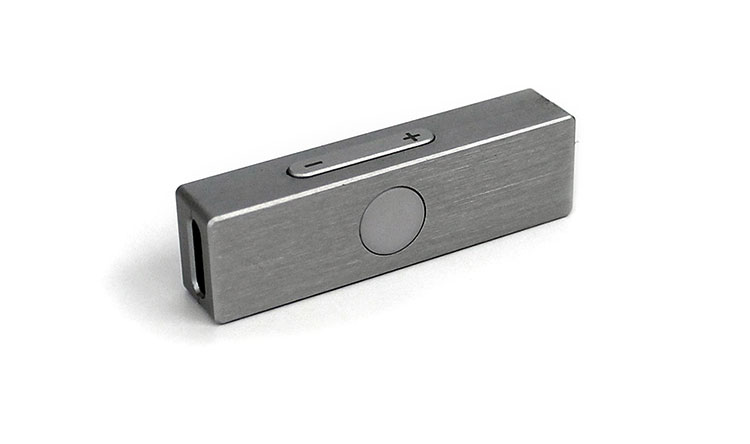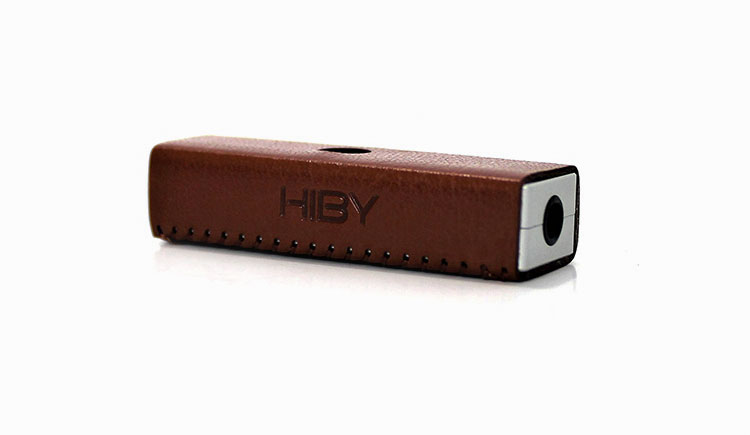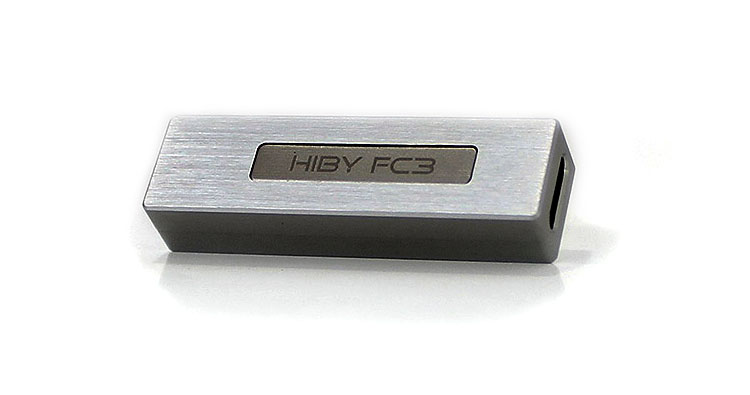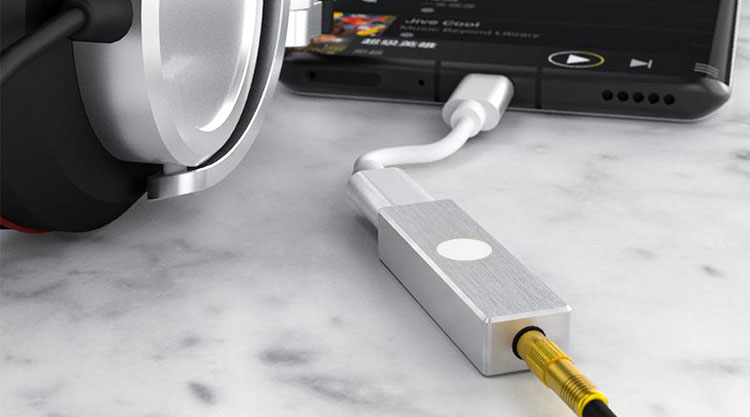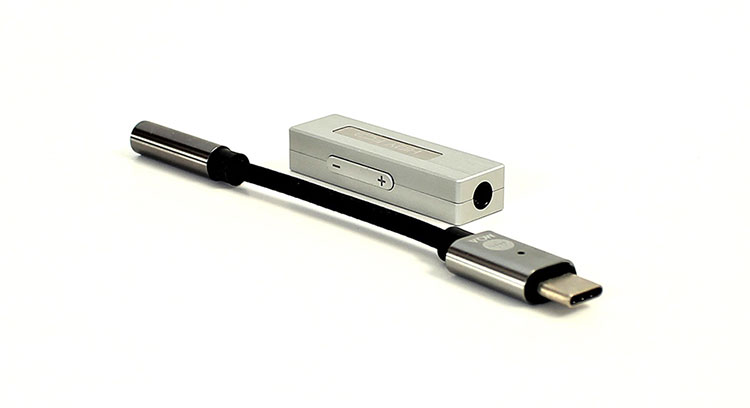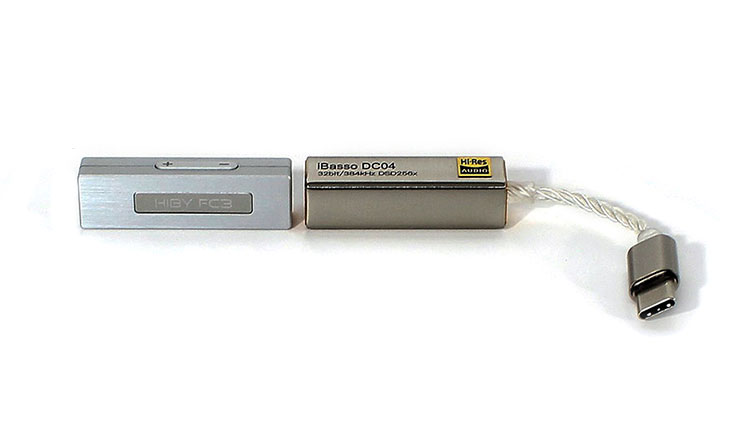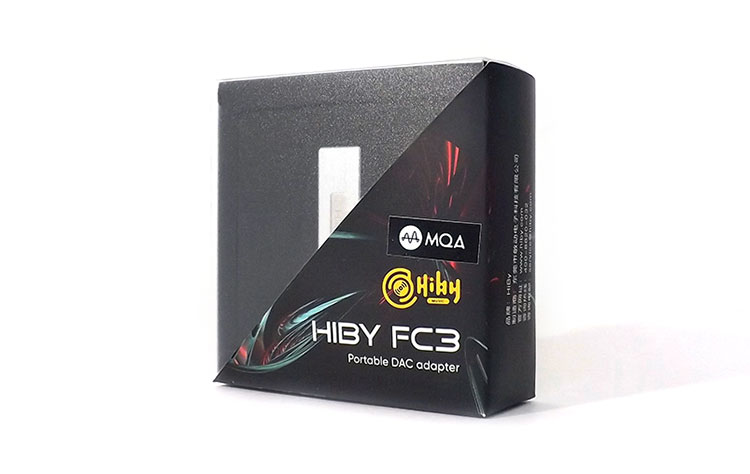The HiBy FC3 is a compact USB DAC/amplifier dongle capable of DSD128 and MQA decoding, as well as up to 70mW of output power. It is priced at $69.
Disclaimer: The HiBy FC3 was sent to us as a sample in exchange for our honest opinion in this review. We thank HiBy Music for this opportunity.
To learn more about HiBy reviews on Headfonics you can click here.
Note, this review follows our new scoring guidelines for 2021 which you can read up on here.
Micro DAC dongles are coming at us fast. The tech is cool and somewhat still a mystery to me on how they pack so much technology and features in such a small device and it is quite amazing they could make something so small while still capable of producing the quality audio some of these micro DACs are capable of.
I have several micro DAC dongles and each one has its particular good points, some more than others. They all do the same basic job of taking a raw USB signal off a phone or a laptop and the internal DACs convert the signal to analog to then amplify the signal enough to power up headphones.
The Hiby FC3 does just that and it came in recently for review, The FC3 micro DAC dongle has some of its own unique features and points of interest.
Tech Highlights
The Hiby FC3 is a USB-powered micro DAC headphone amplifier dongle device capable of taking the raw digital audio signal from any PC, laptop USB port, or most phones equipped with a USB-C OTG compatible device and converting the signal to an analog headphone output.
Among the micro-DACs that I own this is the only one with a physical 2 sided rocker-type volume control which upon operating one could tell for certain it operates the volume in the digital realm by using incremental steps.
The Hiby FC3 is Hi-RES certified and capable of a 70mw per side output at 32 ohms while still boosting low power consumption. The amount of rated power output I would consider ‘in-the-mix’ amongst other micro DACs. Some have more power as well as some which are below FC3 power output specification numbers.
ESS DAC
At the heart of the Hiby FC3 is an ES9281PRO chip which is the same SABRE chip used in the Earmen Sparrow. The key difference is that the Sparrow has a balanced headphone output while the Hiby FC3 uses a single-ended headphone output.
A never mentioned feature of the micro DAC dongle that gives these units additional versatility is the capability of acting as a line-level drive stand-alone USB DAC by simply converting the 3.5mm output to dual RCA jacks and plugging that into an amplifier. The ES9281PRO has a specified maximum output of 2.0 volts which is ideal for that purpose.
This particular ESS SABRE chip claims a signal-to-noise ratio of 124dB with a low total harmonic distortion plus noise at -112dB bringing it closer to being worthy of earning the Japan Audio Society’s HiRes audio quality certification.
Decoding
The Hiby FC3 can playback basically anything you throw at it in the form of digital audio. You could playback the usual digital PCM files plus DSD and even unfold MQA files if you need to. There is no mention of DXD, however, since my music collection consists of mostly FLAC files and some MP3s I did not push the FC3 on that front.
The PCM side starts at 32BIT/32-48 kHz with a max decoding ceiling of up to 32BIT/384kHz as well as DSD128 and MQA unfolding up to 4X.
I threw most files I could come up with and had no issues with breakup or decoding issues. Some of the formats I tried are FLAC, MP3, WAVE files, and all were perfectly decoded by the FC3. No issues with compatibility either on a PC as it is Plug and Play on Windows 10. The FC3 is fully a plug-and-play device on any device really including OTG capability.
RGB Indicator
Whatever files the Hiby FC3 decodes through the DAC section, the unit displays on its LED a different color accordingly to let the user know what type of file it’s presently converting. Blue means the unit is running 48kHz files, green is for PCM 192kHz or DSD64, light green is for 384kHz and DSD128 while Purple is for MQA.
Nowadays, this feature is common in micro DAC dongles but most use a simple LED. What’s is less common with this one is the style of the light itself kind of like a Chord DAC orb system. I think all LED indicators should look like this one.
The amount of light the indicator emits is subtle and gives a gorgeous glow and is only hard to see in the brightest of sunlight. In a dark room, it does not light up the area and does not emit a blinding amount of light. This backlit indicator is artfully done with a modern new-age vibe design plus it’s very easy on the eyes.
Design
So the Hiby FC3 is a DAC and headphone amplifier with a female USB-C port, a female 3.5mm headphone jack, volume control, and an RGB LED window. All of this is housed in a compact brushed aluminum shell that measures a mere 45x12x9mm and at a weight of a little over 9 grams.
I must admit, the Hiby FC3 has implemented probably my favorite micro DAC dongle design here. Why? Not so much because the body is made of brushed aluminum or the cute format of the indicator light but because it has no attached wires which are the weak point in almost every other micro DAC design. This improves longevity in my opinion.
This little device is quite unique considering the features it has on its body which most micro DACs do not include but still maintains an ideal size for portable use. This is not a chunky piece of gear either that will make a hole in your pocket because of its weight or price.
Accessories
The first thing that stands out in terms of accessories is the cute faux leather cover that comes in the box with the Hiby FC3. Officially, it’s probably the smallest I have or seen. It has the Hiby emboss with visible stitching and it also has cutouts for the RGB LED and an embossed volume indicator.
The Hiby FC3 works on a PC, Laptop, or Android phone so Hiby includes 2 wires which are sufficient for the three devices but do not include any connectivity for Lightning-equipped phones or any other Apple gear. I am almost certain you could easily source one from a third-party vendor and it will probably work out fine.
A user manual along with a warranty card and a QC certificate completes the list of accessories in a simple but ample enough box to get the contents home safely.
Packaging
The box is a two-piece set with an outer piece cut at a 45-degree angle and an inner box that simply slides out the first box. The inner black box has a transparent vinyl cover and somewhat displays the DAC. I say somewhat because the cover is somewhat opaque.
The inner black box holds all the goodies including the FC3 micro DAC and all the accessories. The DAC is displayed center while the contents are hidden from view inside the box.
Sound Impressions
Summary
Off the bat, of course, the Hiby FC3 produces better sound than most laptop onboard soundcards and definitely a step up in sound quality over any phone I have used, Android or Apple alike. Unlike those devices, this one earns the HiRes label by sounding clean and dynamic with some punchy aspects behind it.
The FC3 although somewhat forward, aims at a neutral-toned, clean presentation free from hiss and does a well enough job keeping the USB port from introducing anomalies and the previously mentioned hiss. I tested the FC3 with some hiss-sensitive IEMs and heard none or very little except for some recordings which had some hiss present within the recording.
Frequency extension does not seem to be a problem with the FC3 as there is lots of shimmer and sparkle up top and the bottom end, although not a strong point of the FC3 because of limited power, manages to produce the lowest bass notes especially if you boost the bass a few decibels as I do at the very bottom octaves.
Running a tone sweep generator on the FC3 proved it to be capable of producing sub 20Hz frequencies and is also capable of producing frequencies my ears were incapable of picking up since it dropped out of audition at my max high-frequency hearing capability.
Imaging
I tried several IEMs and some full-sized cans including planar magnetic full-sized headphones and they all imaged well contrary to some budget kit DACs that sound narrow and compressed to me. I know of some more expensive DACs that do worse than the FC3.
I obtained very good 3D positioning from the Hiby FC3 in combination with many IEMs for example the FiiO FH5s, or even with the See Audio YUME.
If they have a wide stage the Hiby FC3 will not hinder it to the point of sounding narrow. Most IEMs I used presented excellent height, width, depth, and a good 3D picture was painted long as the IEM had the capability.
Dynamics
If you consider the size and the amount of power ratio the FC3 is capable of then it amazes me even more because the dynamic range is very good. I was able to obtain a decent amount of attack and decay from most of the headphones and IEMs I used.
But the FC3 should be reserved for efficient headphones and IEMs to obtain the best results for volume, dynamics, attack, and delay.
It does have a peculiar characteristic similar to a hybrid class A design in where the first half of the volume gain is low up until you hit around the three-quarter mark and at that point, the volume rises fast and gets loud quickly using the rocker volume control.
Synergy
The Hiby FC3 works best in situations where you cannot upgrade the sound aspect of your device, for instance, a phone or a laptop. If you own a PC you could always get a decent sound card but you run the inconvenience of having to open your PC case to install the device, not to mention having to deal with drivers that sometimes are finicky and buggy.
I like to pair the FC3 with my phone mostly for portable convenience and sound improvement over the onboard sound. My second choice of use would be using the FC3 with a laptop because you simply cannot upgrade a laptop sound card so this device is a blessing in that case.
Pairings
What kind of headphones would I use with the Hiby FC3? I would stick to very efficient full-sized headphones but mostly to IEMs.
Somehow volume seems low at times and somewhat simulates hybrid power that uses class A in a first stage till you open up the volume and at one point the volume rises on the top of the range exponentially and is more noticeable with full-sized cans.
Pairing the FC3 with my Sundaras would give an adequate volume but nothing near what I would consider loud. It pairs better with dynamic headphones especially if they have a high-efficiency rating.
Selective Comparisons
Zorloo Ztella
Technical
If you want a noticeable audio upgrade on either your phone or a laptop and want to upgrade in the most inconspicuous way then the Zorloo Ztella is a great option. The Ztella takes up as much space as a dongle wire and is the smallest of its type around.
The Ztella has all the electronics inside the very small in size USB-C connector and is a simple connect and use the device just like the Hiby FC3 and both are plug and play on PC and do not require drivers.
Similar to the FC3, the Ztella is capable of running PCM or DSD and you can get the Ztella with the optional MQA playback capability to even out the playfield literally but at a slightly higher cost. Zorloo also keeps up to date their Ztella with firmware updates.
I did say the Hiby FC3 is my favorite design because there are no wires attached to the unit and the Zorloo Ztella does and is actually almost all wire but the wire itself is wrapped in cloth and is probably the most durable wire you could use in the particular scenario.
Performance
If one was to judge both these micro DACs a good place to start is power output. The Zorloo Ztella has two rated power outputs and lists them both in voltage. The Ztella has an output of 1 volt when it sees a load of 150 ohms or less and 2 volts above 150 ohms. I personally would stick to low impedance IEMs with both these devices.
The problem here is that most people will not use headphones with impedance higher than 150 ohms in a portable scenario so most people will not benefit from the full power capability of the Ztella.
Since the Ztella limits itself there is a flip side both ways far as benefits. Since power is limited battery usage is reduced. The Ztella also tends to sound cleaner, especially at its highest volume setting. The FC3 has a higher volume output but when you start to reach the top volume levels some breakup occurs.
Of course, there is a point in volume which levels itself with the Ztella volume and at that point, they both sound almost the same. Both units have a neutral character that does not push any area more than others and they both strike a good tonal balance and are both worthy of the Hi-RES label.
iBasso DC04
Technical
If the Ztella and the FC3 are opposites then the iBasso DC04 takes it to the other end by being the chunkiest and largest unit of the three, plus it has the most driving power of the three.
Let’s compare codec capabilities first which is basic on the DC04 with DSD and PCM capabilities but there is no MQA that is available on the FC03. DSD is strong at 256 which is the higher of the other two units and it is also capable of 32 bit up to 384Khz so if your interest is in PCM and DSD look here.
Construction is robust and the DC04 is made of metal but the USB-C male connector is tied to a braided wire which is a weak point in the build. I would hate for the wire to become intermittent after a couple of accidental yanks on the wire.
Other than that, there is the limitation on the DC04 of having to use a Pentaconn 4.4mm TRRRS plug but you gain a balanced output that will push even some full-sized Planar magnetic headphones to very loud volume levels.
Performance
Speaking of loud, the iBasso DC04 is definitely the most powerful of all my micro DACs and has an almost desktop amplifier sound because of the 195mW per channel capability with a maximum voltage output of 4 volts which is double what the FC3 is capable of and 4 times the power of the Ztella when driving low impedances.
Of course, the DC04 will have more power but the one inconvenience it has is that the headphone out is a single 4.4mm balanced output and you might just have a few favorite IEMs around you want to power up with the more conventional 3.5mm plug.
Dynamic range improves with power most of the time and the DC04 demonstrates that. However, battery drain is highest on the DC04 so if you plan to use a dongle DAC with your daily phone then this is something to consider.
On the other hand, you might not have as much brute force behind that jack but the Hiby FC3 sits in the middle of the bunch when it comes to battery drainage and available power and it has ample power for most IEMs.
Our Verdict
The Hiby FC3 sort of sits in between all the now available dongle DACs on the market but in no way lacks functionality which is rather high on this device.
It might not power those 600Ω AKG headphones you have stored or might not be the right choice for planars that many own but practically any IEM is game and lots of full-sized dynamic headphones will play well with the FC3.
It’s a good time for audio because 10 years ago there was nothing that sounded this good with so much versatility for anywhere close to the asking price.
The Hiby FC3 is a piece of well-constructed hardware that goes anywhere you want it to go and it improves the sound of any phone or laptop two or three times over for under a hundred bucks. What is there not to like about that?
HiBy FC3 Specifications
- Dimensions 45x12x9 mm
- Weight 1 grams
- DAC Chip ES9281PRO
- DSD Support Up to DSD128 (DoP)
- Indicator Light 1 RGB LED Status Indicator
- USB Port Type C
- Headphone Port Standard 3.5mm TRS (Does not support Line Control)

